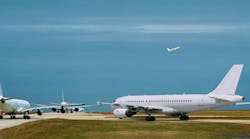By John Rhea
WOODBRIDGE, Va. — The U.S. Marine Corps is employing advanced vapor-cooling techniques to support initial use of commercial off-the-shelf (COTS) technology in the Advanced Amphibious Assault Vehicle (AAAV). Managers of other weapons platforms are watching this effort for possible emulation.
Successful environmental testing of vapor-cooled AAAV components to date is "the pointed end of the spear to mature this [COTS] technology," says Lt. Col. Harry Oldland, AAAV acquisition program manager at the Marine Corps Advanced Technology Center in Woodbridge, Va.
Other candidates to employ vapor cooling include the U.S. Navy's EA-6B Prowler carrier-based electronic warfare aircraft, the U.S. Air Force F-16 jet fighter, and the U.S. Army's M1A1 main battle tank, he notes.
Experts conducted the tests late last year at the Patuxent River Naval Air Station in Maryland as part of the current AAAV demonstration and validation (DemVal) phase.
Marine Corps leaders intended them to validate the use of vapor cooling methods pioneered by Isothermal Systems Research (ISR) of Clarkston, Wash., and thus enable the Marine Corps to use COTS boards in the particularly demanding environment of ground combat vehicles.
Marine Corps experts really had no choice, Oldland says. The command variant of the AAAV, which runs on the Solaris operating system, has two VME boards for the vehicle's command, control, communications, computers, and intelligence (C4I) function. No existing boards could do the job, Oldland says. He estimates that customized boards, if they could be developed, would cost $25,000 to $30,000 each.
Oldland recalls that he found a way out of the impasse during a meeting with ISR president Donald Tilton at the Military & Aerospace Electronics COTScon East '99 conference in McLean, Va., in May.
Tilton's solution was to use a coolant known as Fluorinert from 3M Co. to spray the electronic components within the boards and thus transfer the heat to the chassis, which acts as a heat sink.
This technique has been proven in the superconductor industry and approved by the Occupational Safety and Health Administration and the Environmental Protection Agency, Tilton says.
ISR officials had been looking for military applications, and received about $300,000 from the Defense Advanced Research projects Agency in Arlington, Va., to fund a risk-mitigation effort and build a brassboard using the technique.
Based on the Marine Corps' interest, the Navy put in an additional $6 million to push the technology forward and conduct a proof-of-concept effort with an eye toward transferring this approach to other programs and achieve commonality among platforms. The EA-6B is considered a particularly likely possibility.
In addition to cutting costs by allowing the use of COTS — Oldland estimates the commercial boards will run $5,000 to $8,000 — the cooling technique also opens the door for technology refresh. The VME boards on the AAAV now contain 166 MHz militarized Pentium microprocessors, but he looks for migration to 500 MHz.
AAAV program officials envision production of 1,013 vehicles, 78 of the command variant and 935 of the personnel variant. Successful implementation of COTS in the command vehicles could lead to future use in the personnel versions — and for other functions beyond C4I.
Thus, life cycle cost savings on the program could exceed $300 million, says Craig Lamond, head of AAAV electronics and software at the Advanced Technology Center.
The hermetically sealed VME chassis enables designers to use non-militarized convection-cooled components, Lamond says. Oldland adds that this is basically the reverse of the usual specification for operating in a marine environment in which designers must keep fluids out of the box. Now the seals also retain the cooling fluids within the box. The fluids are non-volatile and pose no risk to personnel, but their loss would halt electronic functions.
As the schedule now stands, AAAV low-rate initial production is due to begin in 2005 with the first deliveries that year and initial operational capability the following year.
The prime contractor is General Dynamics (GD) Land Systems of Sterling Heights, Mich., yet the company has established a separate division, GD Amphibious Systems, based at Woodbridge, Va., as part of an integrated product team.
The three AAAV prototypes in the current DemVal phase are assembled in a high bay area at Woodbridge using tank hulls from the GD facility in Lima, Ohio. The ultimate production facility for AAAV is still to be determined.
In the tests at Patuxent River, the COTS boards survived basic shock of 40 Gs, six levels of vibration in each axis, altitudes as high as 40,000 feet (non-operating), and ambient air temperature from -31.6 to 52 degrees Celsius, according to the summary results.
Oldland explains that the spray-cooling technique also improves the shock and vibration characteristics by reducing the mass of the board.
Duncan Young, director of marketing for VME board maker DY 4 Systems in Kanata, Ontario, is also monitoring the results of the Marine Corps tests. Young, whose company supplies Power PC single board computers to the AAAV program, has an eye to applying this cooling technique to other products.
Even more demanding environments, Young says, will be missiles and spacecraft, but he notes that implementation on combat vehicles should contribute to improved situational awareness.



